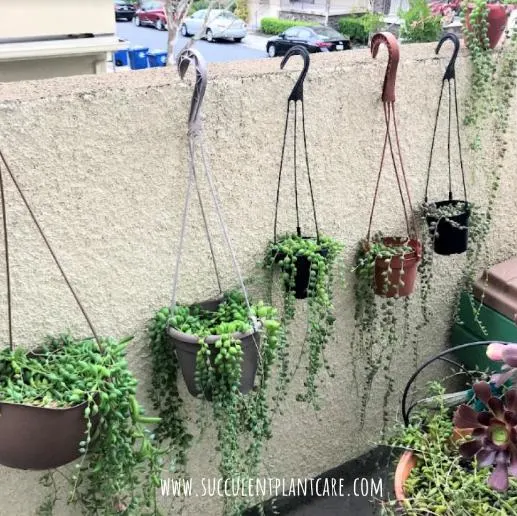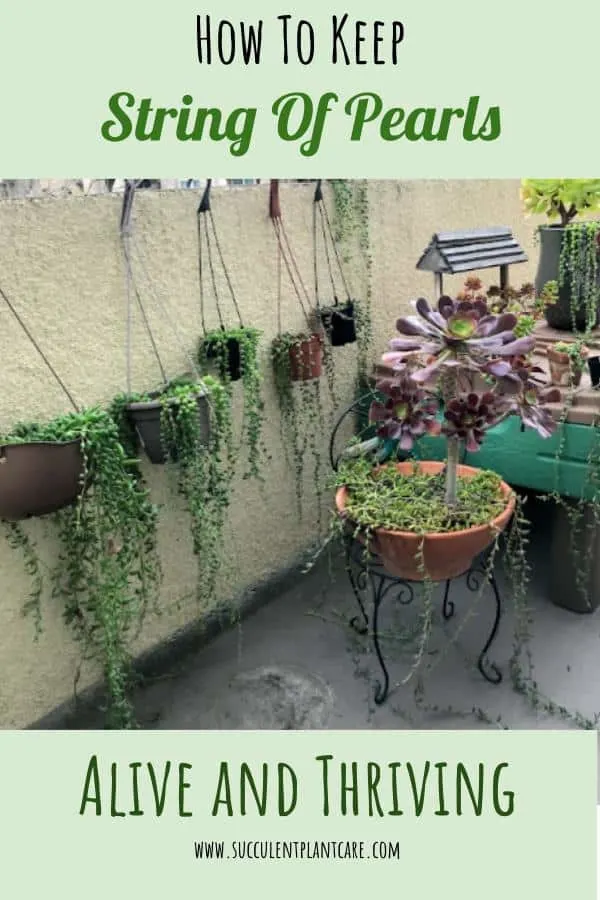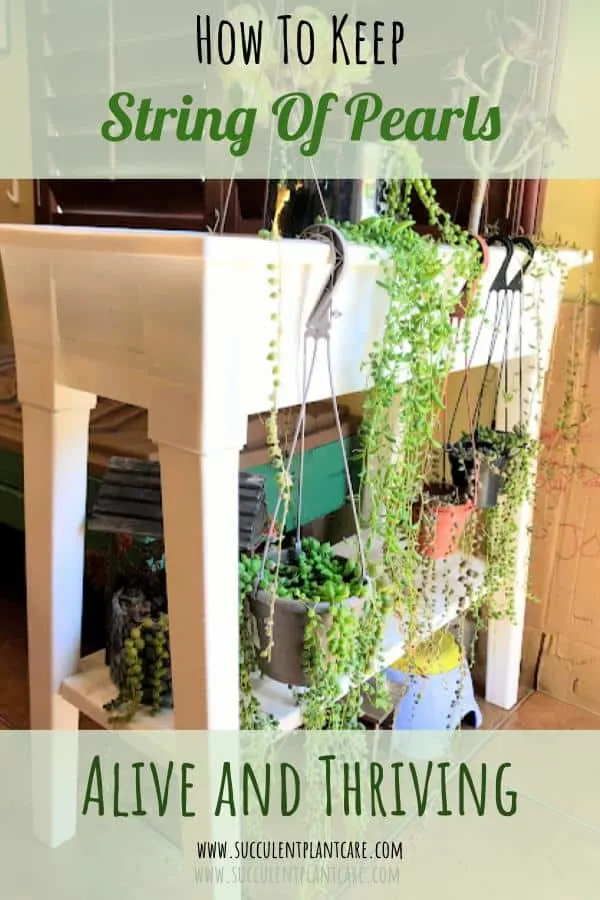The String of Pearls plant can be difficult to figure out. Some people seem to be able to grow them like vines while some can barely keep them alive. I’ve been on both sides of the equation and I can put my two cents in on how to keep these plants alive and thriving.
Below is a picture of my String of Pearls collection. But it wasn’t always this way. I started with one or two pots of these plants and almost immediately started having problems with them. I couldn’t tell if they needed more water or less, and why they kept shriveling and eventually dying.

But through it all, I have managed to salvage the plants that I had and keep them alive, which eventually grew into this little collection of mine. Here’s what I’ve learned after my initial problems with these plants.
Tip # 1: No direct sunlight
String of Pearls needs adequate sunlight to grow and thrive. But how much direct sunlight does it really need? I learned early on that these plants tend to shrivel and dry up when exposed to too much sun.
String of Pearls will not do well under direct sunlight. They truly do not do well under intense heat or full sun. These plants are not one of those plants that can get acclimated to full sun. When outdoors, they prefer a bright location but protected from direct sunlight. Partial shade is much preferable. They will shrivel and dry up when left unprotected in direct sunlight for too long.
If you leave your String of Pearls outside as I do, make sure to provide proper shade for your plant. Find a spot where the plant can be protected from direct sunlight, especially afternoon sun when the sun’s rays are the most intense. Mines get plenty of morning sun and some indirect afternoon sun.
The way I keep them protected from direct sunlight is I hang them in shaded areas outdoors or under a taller plant and I make sure they are not getting full sun. Here are some sunshade recommendations if you need them for your plants.
Tip #2: Provide Proper Lighting Indoors
Since the sun’s rays are naturally less intense indoors than out, you do not need to worry about String of Pearls receiving too much sun indoors. However, you need to make sure that they receive adequate lighting indoors.
When kept indoors, String of Pearls need to be placed in a location with plenty of light. Find a bright spot in the house with plenty of light and sunshine. Have the sun hit or shine on the crown of the plant, and not just on the leaves or beads. If you notice that the plant is getting too much sun, such as turning yellow and shriveling up, you can move the plant a few inches away from the window to lessen the intensity of the sun.
Not enough sunlight will cause poor growth and dropped leaves. If the plant does not receive enough sunlight indoors, move it to a brighter location or closer to the window. Consider using a grow light if you suspect that your plant is not receiving adequate sunlight indoors. You may need to supplement your plant’s lighting needs with a grow light for a few hours to keep it happy. When using a grow light, keep the light at least six inches away from the plant to avoid burning the plant. Here are some of my grow light recommendations.
Tip # 3: Know Your Plant’s Watering Needs
Watering is probably the biggest conundrum people have when caring for String of Pearls. How do I know when to water my String of Pearls? The simplest way to tell if your plant needs water is by the way the beads look. When in need of water, the beads start to shrivel and wrinkle, kind of like raisins. This tells you that the plant is very dry and it needs to be watered right away. However, you don’t need to wait until the beads start to shrivel before you water.
The key is in finding the right balance of when to water and when to hold back on watering. String of Pearls does not need to be watered frequently but when you do, water thoroughly and give the plant a good drink. Do not water again until the soil is dry. From my experience, smaller and younger plants need to be watered more than bigger, mature plants because mature plants have bigger beads and more water storage capacity.
Out of habit, I tend to underwater my succulents, including my String of Pearls. I generally do not water my String of Pearls more than once a week. For reference, I live in Northern California and keep my plants outdoors all year long. It is usually dry here, except during rainy days in the colder months.
Watering During Summer
During the warmest season or during a heatwave, I make sure to check on my String of Pearls, provide them some protection from the burning sun, and water at least once a week. Don’t just sprinkle the plant, give it a good drink to make sure it is fully hydrated. During the warmer months, especially in the summer, I water at least every 7-10 days.
When the weather gets cooler around fall and spring seasons, I cut down on watering and water about once every two weeks, sometimes less just because I honestly have too many plants and don’t get around to watering them as often as I’d like.
Watering During Winter
In the winter months, this is when we get a lot of rain in my area so I refrain from watering my plants altogether and rely on rainwater which succulents love. When we have a dry spell during the winter months, I water about once a month.
The rest of the time, I just leave them alone and let them do their own thing. The picture below was taken at the beginning of spring this year, right after the winter season when for the most part, I ignored these plants for months and just relied on rainwater. When I checked on them again they had all grown beautifully and survived the winter frost as well.
Watering During Propagation
The only time I fuss on these plants more is when I’m propagating them. This can be done using stem cuttings. The only time I spray my String of Pearls is when propagating. I spray or spritz them because it seems to be gentler on the cuttings and does not disturb them while you’re waiting for them to root.
The stem cuttings need to be watered or spritzed whenever the soil feels dry. For me that’s usually once a week, no matter the season. I do not let the stem cuttings go for too long without water or they may dry up and not survive. I have a bunch of articles and useful information on how to propagate String of Pearls and have inserted the links at the end of this article down below so please check them out.

Tip # 4: Choose the Right Soil
Using the right type of soil for String of Pearls go hand in hand with proper watering techniques. Knowing when to water and using the right soil are vital to your plant’s survival.
String of Pearls love water, but they do not like to stay in wet soil for too long. Drainage is key for these plants. These plants have thin stems and long, thin roots so it is essential to provide a well-draining potting mix to prevent root rot. Constantly wet soil promotes root rot and disease.
Potting soil that drains well has usually been amended to make it more porous. You can amend the potting soil yourself by simply combining pelite with an all-purpose potting mix (2:1 solution of potting mix to perlite). Another way to do this is to combine cactus mix with perlite (2:1 solution of cactus mix to perlite). You can also use a combination of the three materials mentioned: all-purpose potting mix, cactus mix, and perlite (1:1:1 solution). It doesn’t have to be exact measurements. What you’re basically doing is making the soil more porous by combining it with perlite.
If you prefer not to mix materials, you can go ahead and use something like bonsai jack, which is a pre-mixed cactus/succulent soil that is already very porous. To find these materials online, visit my resource page for recommendations on soil and soil amendments.
Tip # 5: Find The Right Pot Size
Does it matter what kind of pot you put your String of Pearls plant in? I learned this the hard way and this is how I nearly killed my plant early on when I put my plant in the wrong container.
Make sure that your pot is not too big for your String of Pearl plant. Choose pots that are just the right size for the plant you have, which is not too wide in diameter and not too deep. String of Pearl plants have thin stems and even thinner roots. A pot that is too big or too deep gives the plant more room for rot and disease to grow.
Keep it simple. Make sure the pot is just the right size and depth for your plant and that the plant is getting enough aeration. Make sure the plant is not planted too deep in the pot, more than an inch from the rim of the pot. If the plant is planted too deep in the pot, it does not get adequate aeration which can promote fungal growth and rot.
Drainage holes are also a good idea so that excess water can drip out of the pot. You can drill drainage holes in the bottom of the pot if necessary or find pots with drainage holes.
Tip # 6: Repot Newly Bought Plants
Repotting newly bought String of Pearls can often be overlooked. But from my experience, repotting your plant early on is very important and can ensure the survival of your plant.
When buying new String of Pearl plants, they often come with an unsuitable potting mix that either keeps the plant too wet or too dry. Remove the String of Pearls from its original soil mix and repot it into a fresh one. If needed, find a pot that is the right size for the plant, not too deep, and preferably with drainage holes.
Tip # 7: Protect From Frost
Another way to kill your String of Pearls is to expose them to extreme cold. How low can the temperature go before you need to protect your plant?
String of Pearls is not a frost tolerant plant at all. It can tolerate temperatures of around 20°F or -6.67°C. Anything less or any prolonged frost and you need to bring your plant indoors or protect it from the freezing temperatures.
If you have harsh winters, be ready to bring your plants in for the winter or protect them from freezing temperatures. Here are some frost protection recommendations.
My String of Pearls survived the outdoors all winter long here in Northern California this past winter. We do get frost and freezing temperatures here but it’s nothing compared to other parts of the country where winter can be very harsh. We also get plenty of sunshine during the day to keep the plants warm and happy.
Bonus Tip: How to Make String of Pearls Fuller
You may see pictures of String of Pearls looking really full and wonder how you can get yours to look that way. String of Pearls tend to grow really long and become quite heavy. The long trails can weigh the plant down and as a result, the top may start looking sparse. How can you make your String of Pearls look fuller?
To make your String of Pearls look fuller, trim the plant down and add the cuttings to the top of the plant. The stem cuttings will root in a few weeks and will start growing like regular plants. You can keep doing this whenever your plant grows really long. And at some point you’ll have a fuller and healthy-looking String of Pearls plant.
This is the same method I use to propagate String of Pearls, by using stem cuttings. To learn more about how to propagate String of Pearls, here’s a great article I wrote: “Three Ways To Propagate String of Pearls and String of Bananas”.
You may also find these other posts I have on String of Pearls helpful:
Why Is My String of Pearls Plant Dying And How To Save It
Why Are My String of Pearls Shriveling?
String of Pearls Plant-Senecio Rowleyanus Care and Propagation
I hope you found this post will help you keep your String of Pearls alive and thriving. Thanks so much for visiting and as always, happy gardening!
Pin this to save for later or share with others now!


